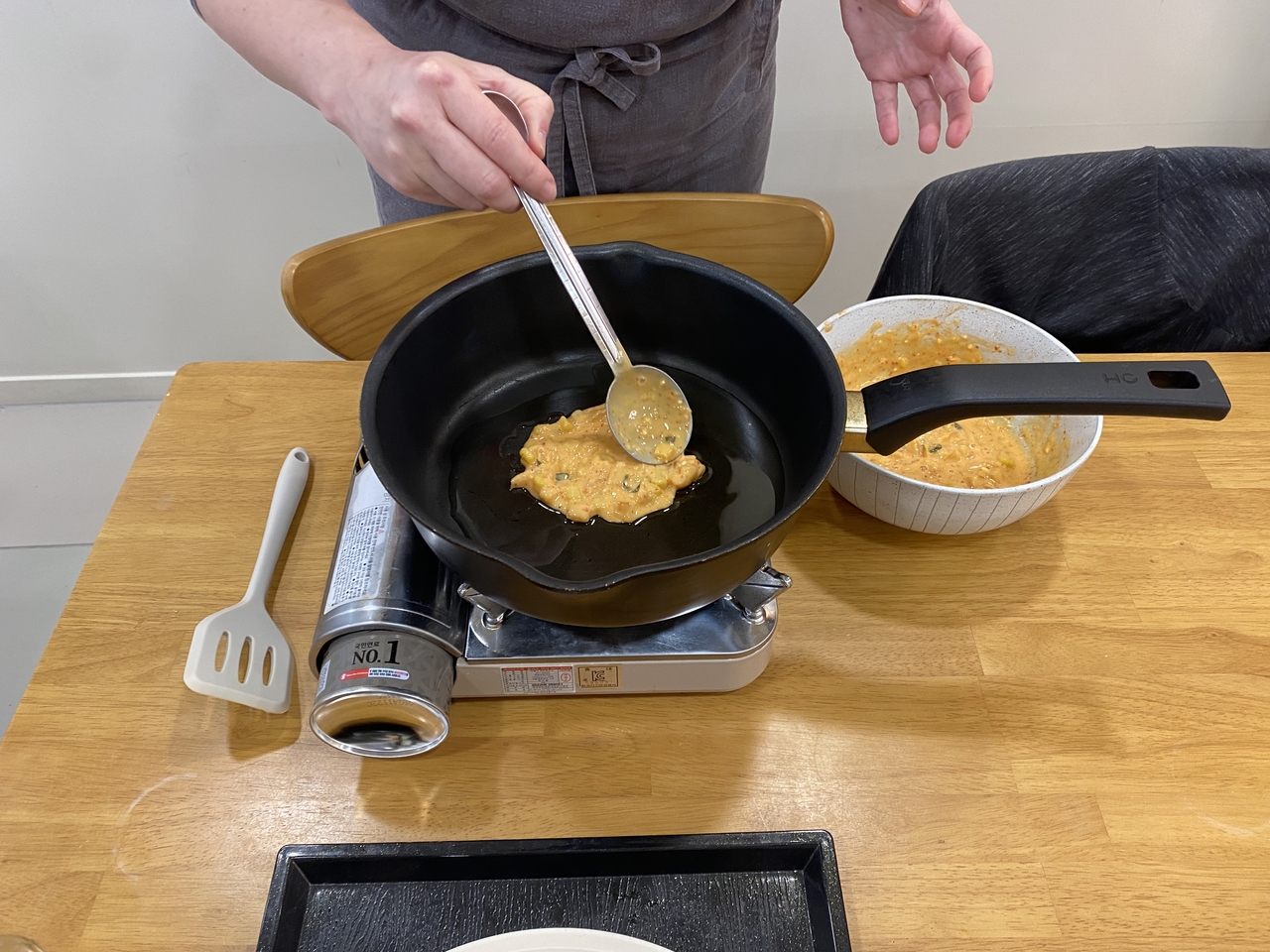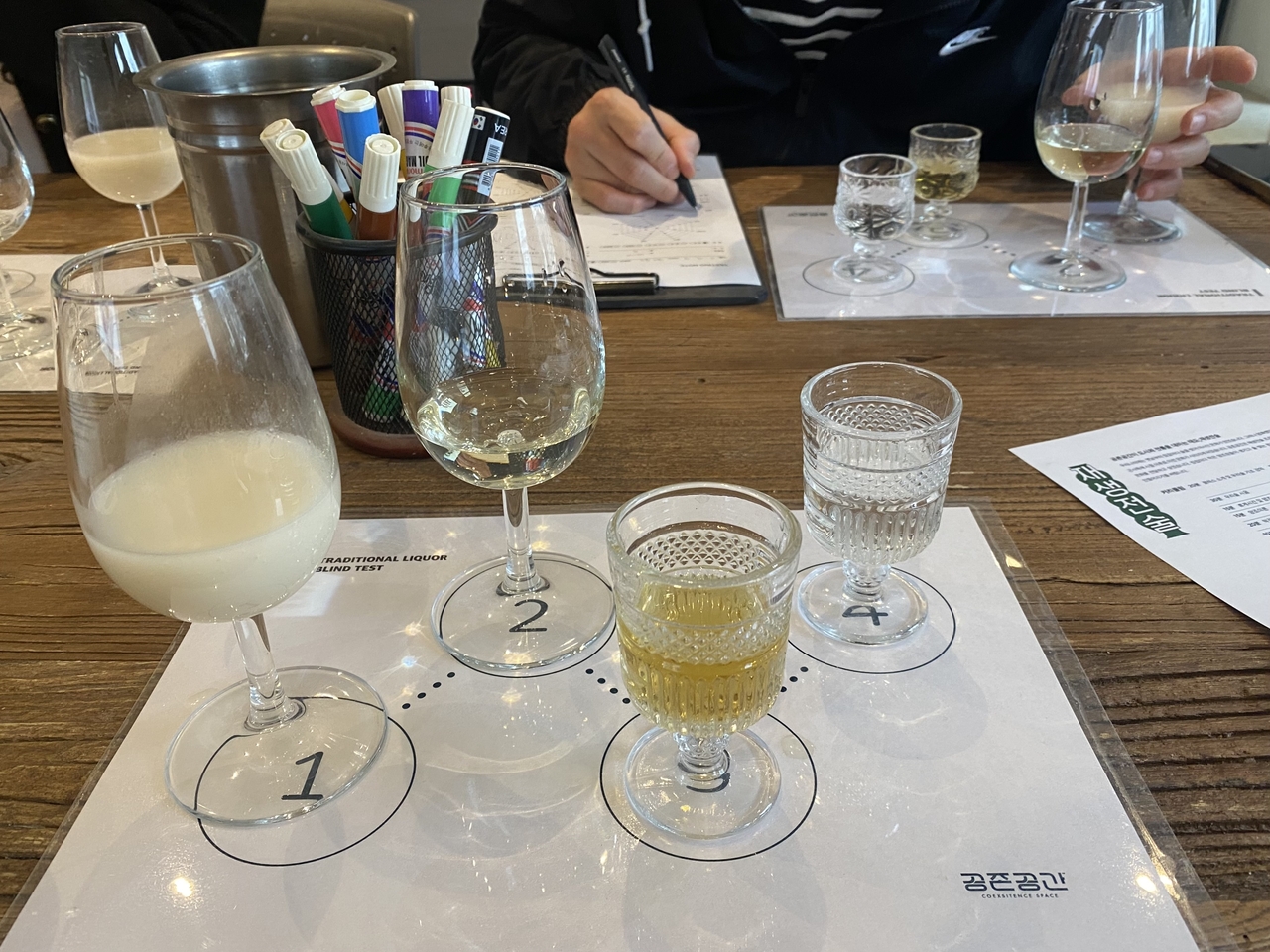April 21, 2025
SEOUL – Once overshadowed by mainstream choices like soju and beer, traditional Korean alcohol has experienced a resurgence since the early 2020s.
The market for traditional drinks in Korea grew from 62.7 billion won ($43.8 million) in 2020 to 147.5 billion won in 2023, and the trend appears to be continuing, with major department stores reporting double-digit on-year increases in their traditional alcohol sales in 2024.
This rapid growth is largely driven by younger generations seeking flavors beyond those offered by mainstream drinks. It is also fueled by the rise of small breweries across the country, which are developing new tastes and textures while staying rooted in traditional methods.
Riding this wave of renewed interest, some breweries now offer hands-on experiences, allowing participants to craft their own customized traditional drinks while learning about the history and diversity of Korea’s alcohol heritage.
On a quiet street near Seoul’s Konkuk University, Suguk offers one of the city’s hands-on experiences in traditional brewing. Its two-hour workshop, taught in both Korean and English, draws curious locals and global travelers alike.
This reporter joined an English-language session at Suguk on making makgeolli, Korea’s beloved milky, fizzy rice wine. The class was led by staff instructor Kwon Hae-den and attended by a French couple visiting Seoul.
Since full fermentation takes over a week, the class guides participants through the key steps — starting with warm, freshly steamed rice. Students spread it on gauze to cool, working together as they gently flip the grains with wooden paddles.
“We’re using sweet rice instead of regular rice to bring out a natural sweetness without adding sugar,” explained Kwon during the session. “Broken rice can make makgeolli bitter, so we should avoid crushing it.”
Once cooled, the rice is mixed with nuruk, a traditional fermentation starter made from grains and natural yeast. Stirred slowly and carefully by hand for about 20 minutes, the mixture turns into a thick, bubbling porridge before being ladled into small pots to take home.
For an extra twist, Kwon encourages adding fruit or flowers to give the drink subtle flavor and fragrance. She serves the brewery’s version made with magnolia, which offers a more pronounced aroma.
The class also includes a brief cooking session featuring anju — snacks typically served with alcoholic beverages. That day’s snack was kimchijeon, or kimchi pancake, served alongside samples of makgeolli at various stages of fermentation.

Gilles Landric, a participant in the makgeolli-making class at Suguk, makes kimchijeon during Monday’s session. PHOTO: THE KOREA HERALD
As the participants at Suguk work side by side — cooling the rice, mixing the ingredients and cooking the snacks — conversations naturally unfold, creating a cheerful, communal atmosphere.
“One of the best parts of the class was experiencing it together as a group,” said Gilles Landric, one of the participants. “We all worked well together in the process of making them.”
For those concerned about carrying a fermentation jar around Korea or taking it home overseas, the class offers a simpler option — a bottle of ready-made makgeolli to take instead.
“Some visitors from overseas say they found our class through travel platforms like Klook and Trazy, or they come across us on Instagram,” said Chung Se-ri, a brewer and lead instructor at Suguk.
She added that the English-language class, held every Sunday to Tuesday, typically hosts two to six participants and can accommodate up to 20.
In addition to hands-on experiences, some classes offer visitors the chance to sample a range of traditional Korean tipples to deepen their understanding of the country’s diverse brewing culture.
One of them is Jasaeng-jeonsul, run by Suwon’s New City Brewing Club near Hwaseong Fortress in Gyeonggi Province.
Like many similar classes in Korea, it focuses on makgeolli for the hands-on portion, as it is relatively simple for beginners to make. Before starting the activity, however, participants also take part in a blind-tasting session that guides them to explore a variety of traditional Korean drinks.
In the class this reporter attended, the selection included the brewery’s makgeolli, a refined rice wine called yakju, a wine made from tangerine and a type of distilled liquor, known as jeungnyuju.

Traditional drinks are prepared for blind-tasting during the hands-on makgeolli class at Jasaeng-jeonsul on Sunday. PHOTO: THE KOREA HERALD
“Visitors are often surprised to learn that there are more types of traditional Korean alcohol beyond makgeolli, and they find it interesting to compare the traditional versions to those adjusted to suit modern tastes,” said Hoang Yong-geun, a brewer and instructor in the class.
“A few participants end up tipsy during the tasting. But they usually recover while stirring the rice during the makgeolli-making session,” he added.
The tasting was done as a game — participants guessed the alcohol level and ingredients added to enhance the flavor of each drink, while also evaluating them across eight aspects, such as flavor, sweetness, acidity and aftertaste.
Before the tasting, the class was given a detailed explanation of the historical contexts behind different types of traditional alcohol, how they differ and how to enjoy them, which enhances their appreciation during the tasting.
“As we occasionally have overseas visitors, some of them even prefer the earthy scent of sogokju — a kind of filtered rice wine — more than Koreans do, and those familiar with stronger spirits like vodka or whiskey often enjoy high-proof drinks like Andong soju, calling them exotic,” Hoang added.
While Jasaeng-jeonsul offers two classes a day for up to eight participants from Tuesday to Saturday, it does not currently offer a regular English-language class. However, they host classes for visiting groups, such as exchange students and tourists, with the assistance of translators.
Further information about Jasaeng-jeonsul classes is available in both Korean and English on its blog and social media accounts.
While there are hands-on classes at small breweries in big cities, Korea is often said to lack attractions like the wineries and historic breweries commonly found abroad — despite the country’s strong drinking culture.
To address this, Korea’s Ministry of Agriculture, Food and Rural Affairs has designated 49 local breweries that offer tour programs, including hands-on experiences and tasting sessions.
Many of these are larger traditional alcohol breweries located outside major cities, aiming to serve as hubs for local tourism.
The list includes sites such as Geumpung Brewery in Incheon, which boasts over a century of history, and the Andong soju distillery in North Gyeongsang Province, where liquor is still produced based on the recipe of the late Cho Ok-hwa, a recognized master of traditional liquor making.
Details about these breweries — including whether they offer foreign-language guidance — can be found on The Sool, a website run by the Korea Agro-Fisheries & Food Trade Corporation.


